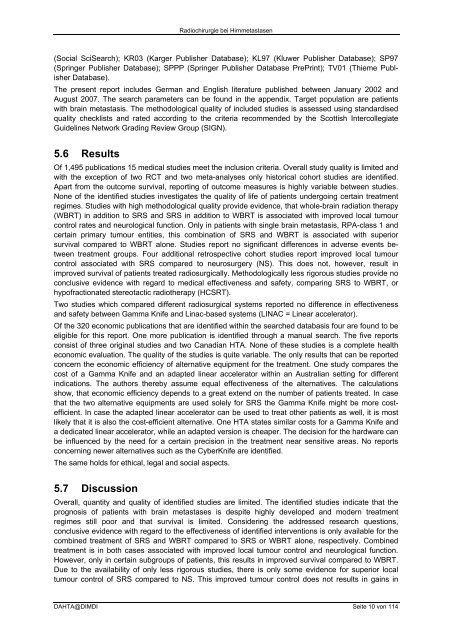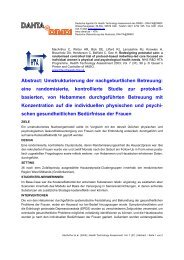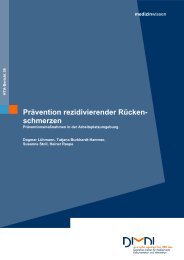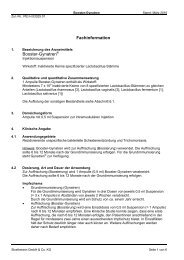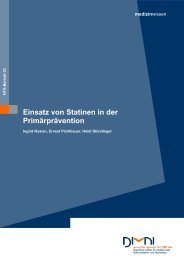Medizinische und gesundheits- ökonomische Bewertung ... - DIMDI
Medizinische und gesundheits- ökonomische Bewertung ... - DIMDI
Medizinische und gesundheits- ökonomische Bewertung ... - DIMDI
Sie wollen auch ein ePaper? Erhöhen Sie die Reichweite Ihrer Titel.
YUMPU macht aus Druck-PDFs automatisch weboptimierte ePaper, die Google liebt.
Radiochirurgie bei Hirnmetastasen<br />
(Social SciSearch); KR03 (Karger Publisher Database); KL97 (Kluwer Publisher Database); SP97<br />
(Springer Publisher Database); SPPP (Springer Publisher Database PrePrint); TV01 (Thieme Publisher<br />
Database).<br />
The present report includes German and English literature published between January 2002 and<br />
August 2007. The search parameters can be fo<strong>und</strong> in the appendix. Target population are patients<br />
with brain metastasis. The methodological quality of included studies is assessed using standardised<br />
quality checklists and rated according to the criteria recommended by the Scottish Intercollegiate<br />
Guidelines Network Grading Review Group (SIGN).<br />
5.6 Results<br />
Of 1,495 publications 15 medical studies meet the inclusion criteria. Overall study quality is limited and<br />
with the exception of two RCT and two meta-analyses only historical cohort studies are identified.<br />
Apart from the outcome survival, reporting of outcome measures is highly variable between studies.<br />
None of the identified studies investigates the quality of life of patients <strong>und</strong>ergoing certain treatment<br />
regimes. Studies with high methodological quality provide evidence, that whole-brain radiation therapy<br />
(WBRT) in addition to SRS and SRS in addition to WBRT is associated with improved local tumour<br />
control rates and neurological function. Only in patients with single brain metastasis, RPA-class 1 and<br />
certain primary tumour entities, this combination of SRS and WBRT is associated with superior<br />
survival compared to WBRT alone. Studies report no significant differences in adverse events between<br />
treatment groups. Four additional retrospective cohort studies report improved local tumour<br />
control associated with SRS compared to neurosurgery (NS). This does not, however, result in<br />
improved survival of patients treated radiosurgically. Methodologically less rigorous studies provide no<br />
conclusive evidence with regard to medical effectiveness and safety, comparing SRS to WBRT, or<br />
hypofractionated stereotactic radiotherapy (HCSRT).<br />
Two studies which compared different radiosurgical systems reported no difference in effectiveness<br />
and safety between Gamma Knife and Linac-based systems (LINAC = Linear accelerator).<br />
Of the 320 economic publications that are identified within the searched databasis four are fo<strong>und</strong> to be<br />
eligible for this report. One more publication is identified through a manual search. The five reports<br />
consist of three original studies and two Canadian HTA. None of these studies is a complete health<br />
economic evaluation. The quality of the studies is quite variable. The only results that can be reported<br />
concern the economic efficiency of alternative equipment for the treatment. One study compares the<br />
cost of a Gamma Knife and an adapted linear accelerator within an Australian setting for different<br />
indications. The authors thereby assume equal effectiveness of the alternatives. The calculations<br />
show, that economic efficiency depends to a great extend on the number of patients treated. In case<br />
that the two alternative equipments are used solely for SRS the Gamma Knife might be more costefficient.<br />
In case the adapted linear accelerator can be used to treat other patients as well, it is most<br />
likely that it is also the cost-efficient alternative. One HTA states similar costs for a Gamma Knife and<br />
a dedicated linear accelerator, while an adapted version is cheaper. The decision for the hardware can<br />
be influenced by the need for a certain precision in the treatment near sensitive areas. No reports<br />
concerning newer alternatives such as the CyberKnife are identified.<br />
The same holds for ethical, legal and social aspects.<br />
5.7 Discussion<br />
Overall, quantity and quality of identified studies are limited. The identified studies indicate that the<br />
prognosis of patients with brain metastases is despite highly developed and modern treatment<br />
regimes still poor and that survival is limited. Considering the addressed research questions,<br />
conclusive evidence with regard to the effectiveness of identified interventions is only available for the<br />
combined treatment of SRS and WBRT compared to SRS or WBRT alone, respectively. Combined<br />
treatment is in both cases associated with improved local tumour control and neurological function.<br />
However, only in certain subgroups of patients, this results in improved survival compared to WBRT.<br />
Due to the availability of only less rigorous studies, there is only some evidence for superior local<br />
tumour control of SRS compared to NS. This improved tumour control does not results in gains in<br />
DAHTA@<strong>DIMDI</strong> Seite 10 von 114


